Mahler 7 at Barbican on Thursday evening, Bach cantatas and concertos at King’s Place on Friday, and a Bach Lute performance at King’s Place on Saturday followed by walking out of the cannibal film Raw, ended up with me waking up before 4am on Sunday to reach the hifi hood in Liechenstein.
I have visited Christoph before, he probably lives in the most scenic location of any audiophile I have been to. We had scheduled this trip much in advance for me to listen to the Apogee Scintilla and to Christoph’s Odeons with KR Sx Kronzilla, but he had a nice surprise for me – the Aries Cerat Diana. So, these notes go through
- Listening to Aries Cerat Diana and KR SX Kronzilla on the Odeon Nr. 38 at Christoph’s
- Listening to the Odeon Nr. 38 with Lamm M1.1 at Christoph’s neighbor, Michael
- Krell KSA 100 with Apogee Scintilla, heavily modded by Henk.
We started with a quick compare of tubes on Christoph’s Lampi Golden Gate, where the PX25 sounded the best, then settled down to compare the KR SX Kronzilla with the Aries Cerat Diana. Now it must be clarified that this Diana is an older preview version and did not have sufficient gain, so we had to use the same Silvaweld preamp for both KR and Diana, using Diana as a power amp only. The newer version of Diana should have more gain.
Acousticsguru on WBF (David), who is also a classical lover, had joined us
Since we were only streaming, I was not able to use my CDs but we were using tracks from Tidal. I have watched Brahms Sonatas by Leonidas Kavakos, Richard Tognetti, and just a couple of weeks ago, Joshua Bell (who also played Brahms Scherzo). Therefore, I started streaming the Sonata no. 3 (Oistrakh) and the Scherzo. Both have violin and piano, the latter more forceful piano. On these, the Diana had a beauty with musicality and decay. Both violin and piano sounded better. KR on these sounded relatively sterile. However, the KR had more grunt and oomph. This was immediately audible on the 4th movement of Scheherazade as well as on Gnomus, where the control and separation from KR with a larger 3D soundstage (top to bottom, more depth) added to the musical enjoyment. On tone, both were close on this, but the KR let you see through a wider scope
When we played Winterreise, the chest and fullness was immediately more on the KR – the midbass is excellent. On Cecilia Bartoli, both were more or less the same. On Old Castle from pictures at an exhibition, I expected the Diana to do better based on the prior violin/piano performance – but here, the control of the KR through the sax, clarinet, and flute made these instruments sound better and fuller, with more insight into each note, as it took us along the up and down wave of the notes. Whenever the orchestra joined in (and the orchestra joins in softly here, not in a loud fashion), the swell and increase in soundstage and the rise and breathing was better with the KR. Based on this, we preferred the KR.
This could easily change for a speaker with easier control, or with the 60w Aries Cerat Diana Forte. To put it simply, the KR is more like a good SS amp in comparison – it has more bass, grunt, drive, dynamics, neutrality, control, while the Diana has a beauty to some notes and a sparkle and a musical decay. Of course, the KR is a valve SET too, so it gives nothing away on SET qualities. And I would like to once compare it with NAT and Silvercore SETs. But one could easily live with either, the differences are something only avid audiophiles into the compare sport will revel in. And we found we could keep listening when the system was plugged in.
It should again be stressed that a newer Diana will have more gain, and there are more models above the Diana integrated in the Aries Cerat stable including the Diana Forte as a separate, while KR is the top stereo, with only the mono version above it, in the KR stable.
And now there is a new KR VA 680 design, which is newer. 60w Stereo
Christoph’s room is challenging. It’s huge, and with glass behind wall to wall, ceiling to floor. Rest of the room also has a lot of openings that lead to the bass escaping. In this room, the Odeons do lose a bit of bass. However, we moved to a neighbor of Christoph’s, who too has the same speakers, a model lower (nr. 32) with Lamm M1.1, and in his room they really sang. The room was much smaller (yet a reasonably sized room), and the bass and integration seemed to match it. The Odeon nr.38s are seamless through the crossovers, and playing Bruch Scottish Fantasia, Emperor’s Piano, Scheherazade, and Winterreise through them was extremely enjoyable. I will be doing another trip here to compare the KR to the Lamms. He also owns the Lampi Golden Atlantic
I have heard the Odeon nr. 28 before with Einstein and NAF, so it was good to listen to the biggest with these amps. The Odeons have a midrange timbre that is less like a horn, and more like an open cone. These can be horns for smaller rooms than the trios would fit in, and at a lower budget. They will compete with horns Universum III, which are more like Quads with more bass and slam than Quads. It is possible that the Odeons have a higher bass but in most rooms, unlike Christoph’s, whether this is an advantage compared to the Universum remains to be seen. Universum have a more Quad like neutral disappearing soundstage. But I am looking forward to comparing a 50w SET with a 110w hybrid amp on a high sensitivity speaker
From here, we moved to another person in the hood who has the Apogee Scintillas. Having heard the rest of the Apogee models multiple times, I wanted to cross this off my list, and was not expecting it to sound anywhere close to a Duetta given the low sensitivity and the Krell KSA 100, especially since I have heard an older Scinitilla with Pass 600 and had not enjoyed it.
Oh man, was I wrong! This was Henk’s all out assault on modding the Scintillas. Where the original Scintillas were around 70 kgs, this was 120 kgs, with a steel frame. It was raised in order to have the mids and the bass ribbon centered around the listener’s ears (the original Scintilla is shorter).
The almost 1000 watts powering into 1 ohm just made it sing. The 5 of us – Christoph, David, the owner Rolf, his wife, and I – listened transfixed as baritone after soprano after symphony played through this. The baritone chest, voice and chorals were fantastic. The mezzo had more density in her voice, more real, than any electrostat I have heard. The soft and hard parts of symphonies were played equally well. This is especially challenging, something that, Mike Lavigne’s system aside, I have heard only Apogees and some SET horns do. Usually in other speakers due to mismatch in drivers, one is increasing the volume either for higher soundstage, better mids, or more powerful bass, and in the process the other drivers end up blowing our ears off. Not so here. Here, we went through a major part of each movement of Scheherazade, because there was a guilt feeling while skipping a track.
There was muscle, there was beef, there was delicacy, and there was a ribbon density. Bach’s cantata with the choral and the baritone, Bartoli’s mezzo delicacy, tuttis, the Apogee stood firm, the Apogee did not budge. This had possibly one of the finest vocals I have heard. Steady, clean, magical, soaring. Somehow I kept thinking about Ron and how much he would have loved these vocals, but how he would cringe when he would hear we were listening to a Krell.
David and the owner Rolf played a Kenneth Jarrett piano jazz recording that I was not familiar with. To me it sounded a bit broken and the piano was not right. David explained that this was a challenging recording, and that 9/10 speakers are extremely bad at it. He added that when he takes it to hifi shows, most gatekeepers who know the recording refuse to play it as it makes the system sound bad. He said he was quite impressed by how the Scinitillas actually handled that part, with more body. The body of the sound was there throughout. Each note had the perfect musical timing. Gone was the hifi that I have been listening to in the past few months. We lost track of how many times we looked at each other with a wow on the natural, yet great bass. The wall moving over the length, in unison – with a decay – I have never ever heard cones do this. Not close. Unfortunately, haven’t heard Maggie’s and Analysis do it either. Sure, SET horns give better liquidity on individual instruments like the piano, where you really need a good expensive SS amp to get that right.
Distance from front to back wall was 5.5m, distance between the inner frames of the speakers was roughly 2.2. Possibly it could have been narrowed for better imaging. Distance from speaker to wall behind was 1.1. Henk reckons that minimum 2m are required from the front wall for better bass. We sat close to the wall behind us.
Yes, the imaging could have been better with the TV out of the way. But this is not a high strung audiophile system. This is a perfect blend of hifi into a family furniture system, without any further OCD. The resolution canatata dac, and the Krell, are not SOTA, and possibly it could be upped considerably with a Lampi, a fantastic analog system, a Gryphon, Symphonic Line Kraft, Boulder, etc – the shortlist of amps for the infamous Ampkilla is, luckily, short. A Scintilla is being refurbed by John Oakey in the UK right now for an user with Gryphon Mephisto – he went from Wilson Sashas, to Apogee Duettas, upgraded his Antileon to the Mephisto, and now is going Scintilla – all in just over a year, he is that smitten by this wonderful beast. And beast it is.
It is sad how much one has to struggle to hear a good Scintilla. I have been trying for 3 years. I got my chance today. Full Ranges and Grands, and then I think Scintilla over the Duetta. Possibly over the Diva as well. Tough to say. Divas will need a bigger room. Or it maybe just Henk’s genius with Graz’s ribbons. But I have recently met quite a few Apogee users who rate the Scintilla over the Divas and the Duettas. Maybe the Duettas image better, more in centre, and soundstage better. Tough to say. The idea to do the steel frame and raise it was Christoph’s implemented by Henk.
Oh yes, there used to be a 1 ohm and a 4 ohm Scnitilla. They discontinued the one with 4ohms as it was generally considered to be less magical. The Scintilla is the only one apart from the Full Range that has a pure ribbon.
But some of the uber systems with fantastic rooms aside, this is by far my favorite room along with Lissnr’s Duettas in New York when it comes to smaller, relatively lower budget system that I would take in a heartbeat over any system other than a Full Range/Grand, a couple of giant horns I like, or a SOTA room system like Mike’s or Marty’s. Practically speaking, this goes on to the final shortlist where I have to decide between a Duetta or a Scintilla, and a bespoke horn.
Next trip, we will listen to these with the Lamm hybrid, which is 110w doubling down.
ps: We quickly went up to Christoph’s attic which is one of my top 2 favorite small rooms, with Acoustat Spectras. This time, I noticed a smaller soundstage, less oomph, and weaker mid bass. On Argenta Espana it became very evident. David noticed the lack too. The amp in use was a KR 30w integrated. I asked Christoph if this was the same one that I had heard. He said no, that one was a much more powerful hybrid, Project Sphinx. That makes sense. The KR is wonderful on the right speaker, but speakers should never be under driven. The Acoustats need power.
But just look at the room. This is a genius room, small and challenging, and with a beefier amp, is fantastic. Christoph also has an Apogee Studio Grand and a movie room with the Apogee Centaurs, so he is a fantastic audiophile. I have heard them before, but did not have time to listen to them this time. It was also great to meet David, who has a great classical ear, and when he lived in Oxford, has been to my favorite concert hall, Sheldonian.

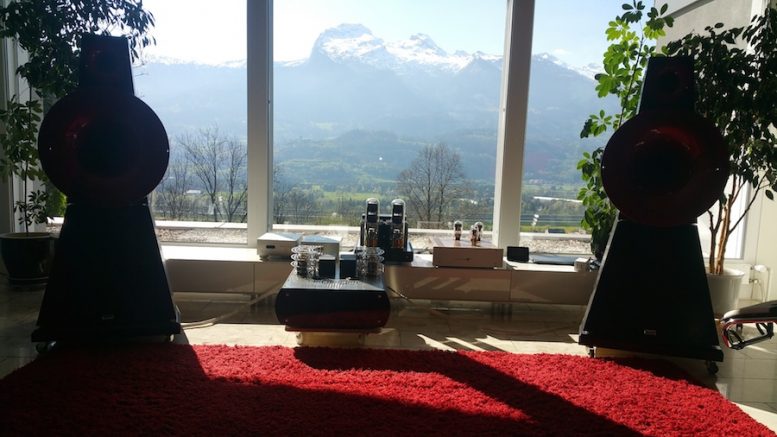
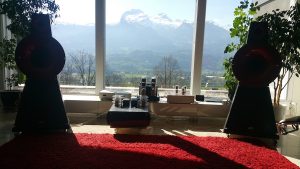
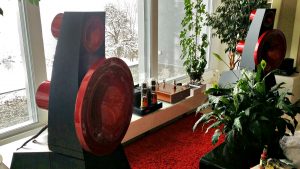
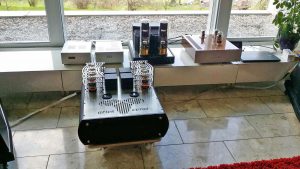
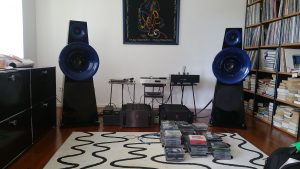
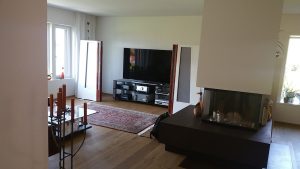
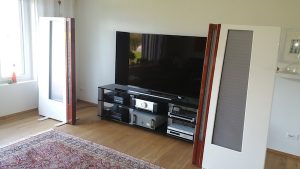
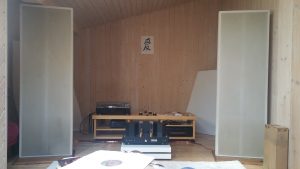
Be the first to comment on "Odeon horns, Kronzilla, Aries Cerat Diana, Apogee Scintilla"